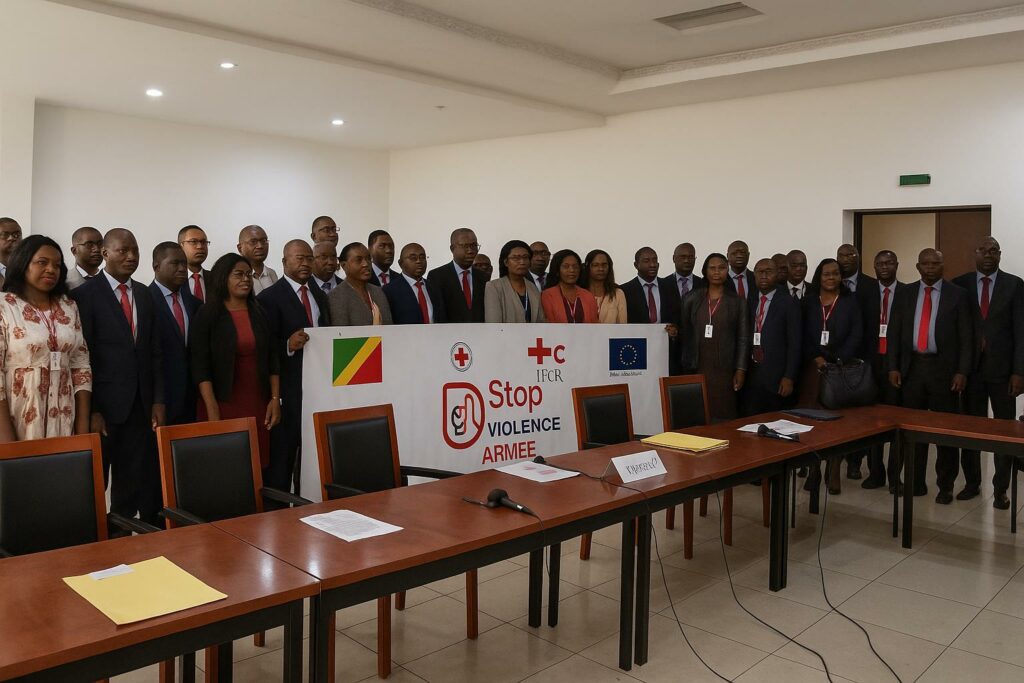Emergency architecture unveiled in Brazzaville
In a carefully choreographed ceremony held on 26 August in the capital, the Congolese Red Cross, with the technical and financial backing of the International Federation of Red Cross and Red Crescent Societies, activated the Disaster Relief Emergency Fund, better known by its acronym DREF. The launch, attended by senior government officials, multilateral partners and civil-society representatives, signalled an acceleration of the Republic of Congo’s cholera response at a moment when the epidemiological curve remains a source of regional concern (official launch communiqué, 26 August 2025).
The Director of Cabinet at the Ministry of Health, Donatien Mounkassa, reminded the audience that cholera is both preventable and treatable, yet currently produces an elevated case-fatality rate in the country. According to the latest consolidated figures, approximately five hundred infections and thirty-five deaths have been registered, underscoring the urgency of a rapid, well-financed intervention.
Cholera dynamics in Mossaka, Loukoléla and Mbamou
While initial disease clusters have started to ebb, fresh notifications in Mossaka, Loukoléla and adjacent villages illustrate the pathogen’s notorious capacity for opportunistic spread along the Congo River’s dense transport corridors. The island of Mbamou, whose limited sanitation infrastructure and frequent cross-border traffic link it to neighbouring communities in the Democratic Republic of Congo, continues to be treated by health analysts as the epidemic’s epicentre. The Ministry of Health’s field assessments emphasise that water quality, population mobility and timely clinical management remain the principal determinants of the outbreak’s trajectory.
The DREF mechanism and its financial implications
DREF has long served as the Red Cross Movement’s rapid-disbursement instrument for small-to-medium-scale emergencies. In the Congolese context, the facility provides an agile channel through which local responders can mobilise supplies, deploy health personnel and intensify community surveillance without awaiting the lengthy pledge cycles often associated with traditional development finance. The framework’s reliance on pre-positioned funds and rigorous reporting requirements is expected to enhance transparency, a priority explicitly endorsed by government interlocutors during the ceremony.
Early projections indicate that DREF resources will empower frontline teams to reach roughly four thousand residents in Brazzaville over a four-month period ending in December, focusing on potable water provision, case identification, household chlorination and behaviour-change communication. The Congolese Red Cross has committed to integrate these activities into the national cholera contingency plan so that redundancies can be minimised and gains sustained.
European Union solidarity and multilevel coordination
European Union envoy Anne Marchal announced an immediate contribution of two hundred and twenty thousand euros—approximately one hundred and forty million CFA francs—to the DREF envelope. This allocation forms part of the Union’s broader humanitarian engagement in Central Africa and is calibrated to complement domestic budget lines earmarked for health emergencies.
Diplomats familiar with the arrangement describe the funding as a vote of confidence in Brazzaville’s stewardship of public health crises, highlighting the Republic’s adherence to the International Health Regulations and its proven record of constructive collaboration within the Economic Community of Central African States. By dovetailing EU resources with those of the IFRC and the Congolese Treasury, stakeholders aim to generate a financial cascade that amplifies the impact of every franc spent.
Government leadership and community mobilisation
Beyond the financial optics, the launch illustrated the government’s resolve to align national policy with community-based action. Health authorities are tasking trained volunteers to relay hygiene messages, distribute oral rehydration salts and record real-time epidemiological data via digital platforms compatible with the Health Ministry’s surveillance dashboards.
Officials underscore that such grassroots engagement is indispensable to the presidential vision articulated by Denis Sassou Nguesso, which places human development and the right to health at the centre of the national agenda. By coupling high-level coordination with local ownership, Brazzaville hopes to contain the outbreak swiftly while reinforcing longer-term systems resilience.
A regional lens on a transboundary pathogen
Public-health strategists caution that no national response can be hermetically sealed when neighbouring territories face parallel hazards. Confirmed cholera cases in Angola’s Cabinda enclave as well as in Kinshasa and the Équateur province of the Democratic Republic of Congo underline the river basin’s epidemiological interdependence. The Congolese authorities therefore continue to exchange situational reports with their Angolan and Congolese counterparts to synchronise border screening protocols and laboratory data.
Such coordination, complemented by the newly activated DREF pipeline, positions Congo-Brazzaville as a proactive actor in regional health security. The coming weeks will tell whether the combined weight of domestic commitment and international solidarity can bend the curve of this latest cholera flare-up, yet early indications suggest a strategic alignment of resources and political will that augurs well for a rapid stabilization of public-health indicators.

